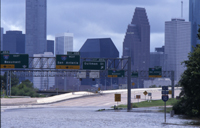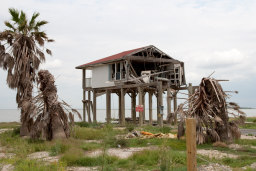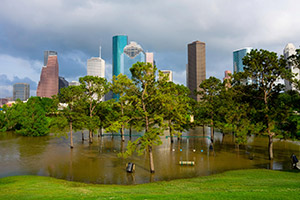How Do I Review My Fema Flood Insurance Policy
FEMA Flood Mitigation Help Grant Program
FY21 FMA Application Period is Open At present
The awarding period for the FY21 FMA grant is currently open up. The borderline to submit subapplications to TWDB for review is December 3. The subapplication timeline is available.
Please notation that homeowners are not eligible to utilise directly for an FMA grant or to register for a FEMA Go account. A community must apply for the FMA grant on homeowners' behalf. If you are a homeowner who is interested in participating in an FMA grant, please contact your local flood official about your interest in the programme. A list of local floodplain officials tin be found here.
To develop a subapplication, the community must first register as a subrecipient in FEMA Become. To get started, transport a request to floodgrant@twdb.texas.gov and a TWDB staff member will help y'all with getting registered in FEMA GO.
Changes for this year's grant cycle include reprioritizing scoring criteria and changes to available funding and funding caps to contain equity and environmental considerations in the grant program more direct. For more than details on these changes and other FY21 programmatic details, please review the FY21 NOFO and the NOFO Factsheet, which are linked to below.
Please also refer to the FY21 FMA Subapplication Timeline, which provides submission and review dates for subapplications.
FMA Program Grooming Opportunities
The 2021 Building Resilient Infrastructure and Communities (BRIC) and Flood Mitigation Aid (FMA) Programs' Webinar Series, hosted past FEMA's Chance Mitigation Assistance (HMA) Division, will run from July 28th through October.
The serial brings FEMA subject area-affair experts and partners together to provide technical information, best practices, tools and resources near the FMA and BRIC programs. The webinars are designed for leaders in states, local communities, tribes and territories, as well equally private sector entities, private non-turn a profit organizations, and individuals interested in learning more nearly the BRIC and FMA grant programs and strategies for how to utilise for them to meet their communities' needs.
- Complete webinar schedule
- Webinars volition exist recorded and posted to FEMA's YouTube channel
FY21 FMA Notice of Funding Opportunity
FY21 FMA Observe of Funding Opportunity Factsheet
FY21 FMA Subapplication Timeline
FEMA Grants Outcomes (FEMA Become) User Guide
FY21 FMA Webinar Training Serial Schedule
 The Flood Mitigation Assistance (FMA) grant plan nether the Federal Emergency Management Bureau (FEMA), provides federal funding to assist states and communities pay for cost effective means to reduce or eliminate the long-term take a chance of flood damage to structures that are insured nether the National Flood Insurance Programme (NFIP). The Texas Water Development Board administers the FMA grant program for the Land of Texas on behalf of FEMA.
The Flood Mitigation Assistance (FMA) grant plan nether the Federal Emergency Management Bureau (FEMA), provides federal funding to assist states and communities pay for cost effective means to reduce or eliminate the long-term take a chance of flood damage to structures that are insured nether the National Flood Insurance Programme (NFIP). The Texas Water Development Board administers the FMA grant program for the Land of Texas on behalf of FEMA.
Goals of the FMA plan include reducing or eliminating:
- repeated claims under the NFIP, and
- the dependence on taxpayer-funded federal disaster aid for disaster recovery.
The FMA program funds are allocated to political subdivisions (Cities, Counties, Special Districts, etc.). Homeowners cannot apply directly to the TWDB or FEMA for an FMA grant. Homeowners may contact their local floodplain officials, or other local officials to discover out about their community's involvement in applying for an FMA grant.
The FMA programme is a nationally competitive grant program with express funds each year. Generally, the political subdivision will develop an application (referred to every bit a subapplication) on behalf of homeowners and submit information technology to the TWDB. FEMA chooses the subapplications to fund based on specific criteria including the eligibility of the proposed project for program funds that year, the cost-effectiveness of the proposed project, and the well-nigh constructive use of grant funds. Projects and plans that offer the best savings to the NFIP over time will be the most successful.
More specific information on the details of the FMA funding cycle can be constitute in FEMA'southward FMA Notice of Funding Opportunity (NOFO). NOFOs are published for each grant wheel, approximately 60 days earlier the application start engagement. The FMA NOFO may as well exist institute on grants.gov. More detailed and technical information on the FMA grant programme is in the Take a chance Mitigation Assistance Guidance and its addendum.
 The Flood Mitigation Assistance Grant application menstruum for FY21 is anticipated to open early October 2021. The TWDB recommends communities begin gathering the data required for a consummate subapplication as early every bit possible. Training for a subapplication may call for extensive collaboration between homeowners, occupants, and community officials in gathering the required documentation. Required documents are projection specific. Lists of the items required for the three most common types pf project subapplications are:
The Flood Mitigation Assistance Grant application menstruum for FY21 is anticipated to open early October 2021. The TWDB recommends communities begin gathering the data required for a consummate subapplication as early every bit possible. Training for a subapplication may call for extensive collaboration between homeowners, occupants, and community officials in gathering the required documentation. Required documents are projection specific. Lists of the items required for the three most common types pf project subapplications are:
- Items Required for Acquisitions Subapplications
- Items Required for Drainage Subapplications
- Items Required for Acme Subapplications
Eligible Activities
The FMA grant program funds 2 chief categories of activities: planning and project grants
- FMA Planning Grants: To develop or update the Alluvion Hazard component of a customs'due south Multi-Risk Mitigation Program.
- FMA Project Grants: To implement cost effective measures that reduce or eliminate the long-term risk of flood damage to buildings insured nether the NFIP. Project grants can be used for but are non limited to:
- acquisition and demolition or relocation of structures,
- construction summit,
- mitigation reconstruction,
- localized alluvion reduction projects,
- dry flood-proofing of non-residential properties and historic residential properties,
- structural retrofitting of existing buildings,
- non-structural retrofitting of existing buildings and facilities,
- infrastructure retrofit, and
- soil stabilization.
Planning subapplications must be used only to support the flood hazard portion of State, tribal, or local mitigation plans, to meet the requirements outlined in 44 CFR Part 201 Mitigation Planning.
Projects subapplications must be consistent with the goals and objectives identified in the current, FEMA-approved Land or Tribal (Standard or Enhanced) hazard mitigation plan along with the local hazard mitigation plan for the jurisdiction in which the activeness is located. A community applying for an FMA Project Grant must have an approved Gamble Mitigation Program in accordance with 44 CFR Part 201.
Application Process
Subapplicant communities develop subapplications on behalf of homeowners. The communities then submit their subapplications to the TWDB. In plow, the TWDB reviews these subapplications for eligibility and includes eligible ones in the State awarding, which is sent to FEMA for consideration.
Eligibility Criteria
A project must, at a minimum, be:
- cost effective and beneficial to the National Overflowing Insurance Fund. The Benefit Cost Ratio must yield 1.0 or greater
- technically feasible; and
- physically located in a participating NFIP customs or information technology must reduce hereafter flood damages in an NFIP community.
A project must as well adapt with:
- the minimum standards of the NFIP Floodplain Direction Regulations;
- the applicant's Multi-Hazard Mitigation Plan; and
- all applicative laws and regulations, such as Federal and State environmental standards or local building codes.
Subapplicant Eligibility
Eligible subapplicants:
- are political subdivisions that are in adept standing with the NFIP,
- accept a FEMA approved and locally adopted Gamble Mitigation Plan by the application deadline (for projection, advance help, and technical help subapplications), and
- include but structures that have active NFIP flood insurance policies, and which must maintain such coverage through completion of the mitigation activity and for the life of the structure.
Cost Sharing and Funding Limitations
The FMA program provides funds to mitigate NFIP-insured properties and has an annual appropriation from the National Flood Insurance Fund (NFIF). The FMA plan has varying cost shares depending on the extent of NFIP claims involved.
Cost Share Requirements
When developing FMA applications, identifying the local toll share source is important. A potentially eligible project may not exist possible if the cost share requirement cannot be met by the community.
| FMA Programme | Federal / Local Cost Share |
|---|---|
| If the project mitigates a property not identified as Repetitive Loss (RL) or a Astringent Repetitive Loss (SRL) or is a drainage or planning subgrant. | 75/25 |
| If the projection mitigates an RL belongings | 90/10 |
| If the project mitigates an SRL property | 100/0 |
Local cost share for an FMA program may come up from a variety of places:
- Some sub applicants provide part or all the local matching funds. These funds can come from general or special appropriations such as a stormwater management fund, or other local funding program.
- It may be passed downwards to the belongings owners, who may be able to use their increased Cost of Compliance (ICC) coverage from a inundation insurance policy
- Donated resources and services may be practical to the matching funds.
Depending on the source of the local match, a Duplication of Benefits (DOB) assay might be required.
Funding Limitations
Project Grants: FEMA may contribute upwards to 100 percent of the total eligible costs for SRL properties. FEMA may contribute up to 90 per centum federal toll share for RL properties. For properties that take not had previous flood claims, FEMA may contribute up to 75 percentage of the eligible activity costs.
Planning Grants: FEMA may contribute upward to 75 percent of the total eligible cost for planning grants. Planning grants are intended only for activities that develop or update the flood run a risk component of a jurisdiction'south Multi-Chance Mitigation Programme, which must run into the planning requirements nether the Code of Federal Regulations Title 44 Office 201. The maximum Federal Share for FMA planning subgrants are $25,000 for local Hazard Mitigation Plans up to $100,000 per country.
 In recent funding cycles, FEMA has offer Community Flood Mitigation Accelerate Help for project development purposed. The bachelor funding varies by twelvemonth. Delight review the current NOFO for more details.
In recent funding cycles, FEMA has offer Community Flood Mitigation Accelerate Help for project development purposed. The bachelor funding varies by twelvemonth. Delight review the current NOFO for more details.
Multi-Hazard Mitigation Program
An approved Multi-Adventure Mitigation Program (Mitigation Plan), whether single or multi-jurisdictional, is an eligibility requirement of a community in order to apply for an FMA project grant.
The Mitigation Program is submitted to FEMA for approval through the Texas Division of Emergency Direction (TDEM). The Mitigation Plan must appraise inundation adventure and place technically viable and toll-effective options to reduce that risk. The Mitigation Plan must draw the planning procedure and public involvement during the planning procedure in developing the Mitigation Plan and must provide proper documentation of its formal adoption by the jurisdiction.
Questions about the FMA program and the application procedure should be directed to floodgrant@twdb.texas.gov
If you are interested in a list of active flood related grant funds in employ by Texas agencies please check out Inundation Related Activeness – SFY2021 Q2.
If you are a local government or entity representative and are looking for more data on available alluvion mitigation funding opportunities for your community, delight cheque out Flood Data Clearinghouse.
If you are a homeowner or renter and are seeking flood-related assistance for yourself or your family, please visit Disaster Assist.
borregowhatumbigh.blogspot.com
Source: https://www.twdb.texas.gov/flood/grant/fma.asp
0 Response to "How Do I Review My Fema Flood Insurance Policy"
Post a Comment